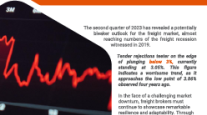Class 8 Demand to Jump 15% in 2014 on Rising Freight Market, ACT Reports
This story appears in the Sept. 30 print edition of Transport Topics.
COLUMBUS, Ind. — Demand for new Class 8 equipment should rise about 15% next year, powered by a stronger domestic freight market and the ongoing need to replace old tractors, ACT Research reported.
Kenny Vieth, president of ACT, gauged 2014 North American production at 298,000 units, up from 2013’s expected total of 261,100. He disclosed the estimate during the consulting firm’s fall seminar here.
The forecast calls for U.S. sales to reach 227,000, up from 196,000 this year, to account for most of the increase.
“We continue to be optimistic,” Vieth said. “Truckers who are feeling better about their business will make it possible for them to buy equipment.”
Jack Allen, chief operating officer of Navistar International Corp., said earlier this month that “we continue to believe there is a fundamental need for replacement vehicles due to fleet age. Combined with improving economic conditions, this is going to result in a 2014 Class 8 industry of 222,000 to 232,000 [U.S. and Canada total] retail sales.”
Meanwhile, the president of FTR Associates said at his group’s transportation conference last week that it believes truck sales for all of North America will hit 243,000 this year, rising to 262,000 next year and to 275,000 in 2015.
“It’s pure replacement this year and additions to fleets over the next two years,” FTR President Eric Starks told Transport Topics.
“Carriers are adding to the overall fleet now, so it’s not likely that they will continue into 2015,” Starks said.
Eli Lustgarten, senior vice president of Longbow Securities, said if industrial production growth is at least 4%, “fleets will expand; under 4%, fleets stabilize.”
Other OEMs were asked for comment by Transport Topics. Spokesmen for Daimler Trucks North America and Paccar separately told TT that the companies would discuss 2014 expectations next month.
New truck sales in Canada should rise to 33,000 from 29,300, while the Mexican market is forecast to rise more slowly to 22,500 from 21,500 this year, ACT said. Shipments outside the Nafta market are pegged to drop to 14,000 from 14,800.
The ACT projections are based on the expectation of 2.6% growth in U.S. gross domestic product next year, faster than 2013.
Operational savings from the latest miles-per-gallon improvements reduce fuel purchases and tilt the economics in favor of purchases, Vieth said.
“These trucks will pay for themselves,” he said, referring to new equipment that can get 8 miles per gallon or more, compared with less than 6 miles per gallon for trucks that predate the 2010 model year.
Another positive factor for equipment acquisitions is rising profits for fleets, which had second-quarter earnings that were the best since 2005.
In addition, the average age of about 7 years for the current Class 8 population remains at record highs and provides another spur to 2014 demand, Vieth said. One-third of the trucks on the road were built between 2004 and 2006, with typical fuel economy of about 5.5 miles per gallon.
Other positive factors underpinning growth, he said, include rising consumer confidence, a stronger housing market, more stability in the job market and recent improvements in demand for durable goods.
New equipment demand hasn’t surged yet because the economy overall still isn’t robust and freight levels are inconsistent. However, Vieth said he expects orders to surge to about 78,000 in the final 2013 quarter, the highest level of the year.
But David Leiker, an analyst for Robert W. Baird & Co., was less optimistic.
“Replacement demand will continue in the near future,” he wrote in a report, “with an inflection in freight demand (against a backdrop of an elevated fleet age and tight freight-hauling capacity) likely needed to drive above-replacement-level order activity entering 2014.”
Vieth agreed that “conditions continue to improve more slowly than we would like.”
Factors that could slow Class 8 production next year include slower-than-expected economic growth as well as worsening shortages of drivers and technicians to operate and maintain new equipment.
Vieth also said that what he termed “an unproductive domestic political climate” could quash economic growth and possibly scale back production by at least 25,000 units.
Still another factor of uncertainty is a lack of visibility into future orders, Leiker wrote, because 32% of trucks now are built in the same quarter that they were ordered. ACT statistics show that 30% of trucks were built in the same quarter since late last year. The current build level exceeds earlier quarters of 2012, when that ratio was about 27%.
News Editor Lorrie Grant contributed to this story from Indianapolis.




